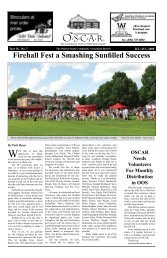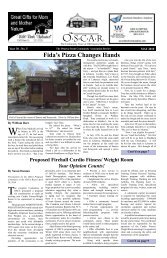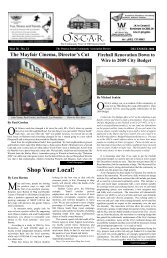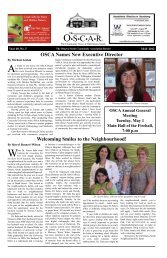You also want an ePaper? Increase the reach of your titles
YUMPU automatically turns print PDFs into web optimized ePapers that Google loves.
Page 12 The <strong>OSCAR</strong> - OUR 38 th YEAR DEC 2011<br />
Bridges of OOS.... Cont’d from page 1<br />
swing bridge remained in service<br />
until 1938 when it was replaced by a<br />
new electrically-powered steel plate<br />
girder swing bridge with a wider<br />
deck to meet increasingly heavy<br />
traffic demands. The new bridge<br />
was erected on the same alignment,<br />
and on widened piers,” wrote Robert<br />
Passfield. The Dominion Bridge<br />
Company of Montreal built both<br />
the 1903 and 1938 Bronson Avenue<br />
Bridges.<br />
“The new reinforced-concrete<br />
bridge was erected in 1959 on a<br />
straight alignment, beside the existing<br />
plate girder swing bridge which<br />
served as a pedestrian bridge until<br />
February 1961 when it was removed,<br />
“ added Mr. Passfield.<br />
In 2008 and 2009 the City of<br />
<strong>Ottawa</strong> rehabilitated the bridge<br />
to upgrade the structure for code<br />
compliance and extend its service life.<br />
The Bronson Avenue Canal<br />
Bridge and the George Dunbar bridges<br />
are connected by a 1.2km stretch of<br />
roadway that moves vehicular traffic<br />
from 80 km/h to 50 km/h.<br />
The City’s collision database<br />
reveals that, “for the years 2002 to<br />
2004 inclusive, there were a total of<br />
177 collisions along Bronson Avenue<br />
from the south end of the George<br />
Dunbar Bridge to the north end of the<br />
Canal Bridge. Of the total number of<br />
collisions, 56 resulted in injuries and<br />
one fatal incident.”<br />
“Further evaluation of the City’s<br />
collision database also revealed that,<br />
between 1990 and 2005, there were<br />
four fatalities on this corridor. Two<br />
of these were on the George Dunbar<br />
Bridge itself (car occupants), one was<br />
at the Brewer Park Road (pedestrian)<br />
and one was between Sunnyside<br />
Avenue and Brewer Way (pedestrian).<br />
Over that same period from 1990 to<br />
2005, there were seven collisions<br />
resulting in serious injuries, including<br />
three on the George Dunbar Bridge<br />
(vehicle occupants), two at Brewer<br />
Park and Bronson intersection (one<br />
bicyclist and one car occupant) and<br />
two in the vicinity of the Canal Bridge<br />
(one bicyclist and one pedestrian).”<br />
“As a result of these serious<br />
collisions, the consulting firm of<br />
Synectics Transportation Consultants<br />
Inc. was retained in March 2005 to<br />
conduct an In-Service Road Safety<br />
Review (ISSR) of Bronson Avenue<br />
between the Rideau River and the<br />
Rideau Canal. An ISSR is an indepth,<br />
independent engineering study<br />
of an existing road using road safety<br />
principles to identify cost-effective<br />
measures to improve road safety.”<br />
George Dunbar Bridge (runs<br />
along Bronson Avenue and over the<br />
Rideau River) is the youngest bridge<br />
that touches our neighbourhood. Built<br />
in 1996, it is made of concrete prestressed<br />
beams. McCormick Rankin<br />
Corporation designed the bridge, and<br />
the general contractor was Dilorio<br />
Construction of Montreal.<br />
The bridge is named in honour<br />
of George Harrison Dunbar who was<br />
born on April 11, 1878 in Richmond,<br />
Ontario. In 1892, he married Lucy<br />
May Coxford, was a teacher, and<br />
served as a captain during World War<br />
I. He represented <strong>Ottawa</strong> <strong>South</strong> in the<br />
Legislative Assembly of Ontario as<br />
a Conservative and then Progressive<br />
Conservative member from 1937<br />
to 1959. Dunbar was controller for<br />
the city of <strong>Ottawa</strong>, and he served in<br />
the provincial cabinet as Minister of<br />
Municipal Affairs from 1943 to 1955<br />
and Minister of Reform Institutions<br />
from 1946 to 1948. Mr. Dunbar died<br />
on February 28, 1966 and is buried in<br />
the Beechwood Cemetery.<br />
The Dunbar Bridge carries the<br />
most traffic of the five bridges in our<br />
community.<br />
According to a traffic study<br />
undertaken for the Lansdowne project,<br />
the Bronson Avenue corridor has, on<br />
average, significantly higher traffic<br />
volumes than the other two primary<br />
north-south corridors -- 1,920 vehicles<br />
per hour (vph) southbound during the<br />
p.m. peak and 1,720 vph northbound,<br />
compared with about 1,000 vph in the<br />
peak direction in each of the other two<br />
corridors.<br />
Under the bridge are legal<br />
graffiti walls. The colourful backdrop<br />
provides space for the House of Paint<br />
Hip Hop festival each August.<br />
Bank Street Canal Bridge also<br />
started its life as a timber swing bridge<br />
in 1866.<br />
“It was only the second bridge<br />
crossing of the Rideau Canal within<br />
the city limits, the other being<br />
Sappers’ stone arch bridge on the<br />
Wellington-Rideau streets alignment.<br />
The Bank Street Bridge was replaced<br />
by a second timber swing bridge in<br />
1882, and by a steel through truss<br />
swing bridge in 1898,” writes Robert<br />
Passfield.<br />
“In 1910 the City of <strong>Ottawa</strong><br />
approached the Department of<br />
Railways and Canals for permission<br />
to construct a new bridge on Bank<br />
Street to carry electric trolley lines,<br />
as well as motor vehicle traffic, over<br />
the Rideau Canal to serve the growing<br />
area of <strong>Ottawa</strong> <strong>South</strong>. Thereafter,<br />
the City Engineer, Newton J. Ker,<br />
designed a high level reinforced<br />
concrete arch bridge having six arch<br />
spans, with the central two arches<br />
spanning the canal, and the northern<br />
arches spanning two lanes of the<br />
recently completed Driveway of the<br />
<strong>Ottawa</strong> Improvement Commission.<br />
The new Bank Street Bridge was built<br />
in 1912-1913 by the City of <strong>Ottawa</strong>,<br />
with a federal government financial<br />
contribution.”<br />
“As originally constructed,<br />
the Bank Street Bridge carried two<br />
electric trolley lines, and two lanes<br />
of road traffic, as well as sidewalks,<br />
and was adorned with concrete<br />
balustrades and iron lamp standards.<br />
Subsequently, the bridge was altered<br />
with the removal of the trolley lines<br />
to accommodate four lanes of road<br />
traffic, and the installation of modern<br />
steel railings and lighting standards.<br />
In 1993, the Bank Street Bridge<br />
underwent a restoration in which<br />
the concrete facing was refurbished,<br />
and the concrete balustrades restored<br />
with replicas of the original lamp<br />
standards.”<br />
Historic picture of bridge:<br />
h t t p : / / c o l l e c t i o n s c a n a d a .<br />
g c . c a / p a m _ a r c h i v e s / i n d e x .<br />
p h p ? f u s e a c t i o n = g e n i t e m .<br />
displayEcopies&lang=eng&rec_<br />
nbr=3358916&rec_nbr_list=3300918<br />
,3358916,3318593,3318592,4134159<br />
&title=New+bridge+over+Rideau+C<br />
anal%2C+Bank+Street.+&ecopy=a0<br />
11237&back_url=()<br />
In mid-November 2011, a mini<br />
bike turning shoulder was added to the<br />
north right side as you leave the bridge.<br />
Designed by David Chernushenko, it<br />
allows cyclists to avoid turning left at<br />
Wilton and cross three lanes of traffic.<br />
Instead, the shoulder allows cyclists<br />
to make a U-turn, circling back under<br />
the bridge and around to access<br />
the dedicated bike lane at Monk.<br />
Also new is “the bike ‘pocket’ at<br />
Holmwood and Bank where cyclists<br />
wait for the green signal to proceed to<br />
an easier way to a quieter route from<br />
<strong>Old</strong> <strong>Ottawa</strong> <strong>South</strong> to the Glebe,” adds<br />
Mr. Chernushenko.<br />
Traffic data from May-June 2007<br />
and 2009 shows the peak-direction<br />
hourly volume on the Bank Street<br />
Canal Bridge has more than 1,200<br />
vehicles per hour (vph) northbound<br />
during the AM peak hour, and almost<br />
1,100 vph southbound during the PM<br />
peak hour on the approach to Aylmer<br />
Avenue. These figures were published<br />
in the Lansdowne traffic study.<br />
Billings Bridge (Bank Street<br />
over Rideau River) was built in 1915<br />
and named after Braddish Billings,<br />
a pioneer who settled and farmed<br />
nearby in 1812. It replaced a previous<br />
bridge, called Farmers Bridge, built<br />
over the river in the same place in<br />
1830.<br />
Billings Bridge has a five<br />
steel beam through plate girder<br />
construction, and is listed as a<br />
heritage structure. According to city<br />
documents, the bridge is supported<br />
on only two lines of girders, parts of<br />
which protrude above the traveled<br />
deck surface. The bridge was last<br />
rehabilitated in 1986.<br />
The Bank Street <strong>South</strong><br />
Community Design Plan suggests<br />
adding cycling lanes in both directions<br />
on the bridge. Brendan McCoy, cochair<br />
of OSWatch, wrote to Jillian<br />
Savage, City Project Manager on<br />
October 26, 2011 and said the group<br />
is pleased with the idea. “It supports<br />
the need for improved pedestrian and<br />
cycling safety and access. We feel<br />
strongly that a vital component of<br />
that is the proper rehabilitation of the<br />
Billings Bridge at the northern end of<br />
this CDP. The rehabilitation of this<br />
bridge presents a unique opportunity<br />
to improve both the safety and quality<br />
of pedestrian and cycling activity<br />
over this historic bridge, which forms<br />
the southern gate to our community.”<br />
Unfortunately the upcoming<br />
interim repairs slated for this bridge<br />
will not be an opportunity to add<br />
additional bike lanes at this time said<br />
David Chernushenko, Capital Ward<br />
Councillor. “The interim measures<br />
will be for concrete, welding and<br />
resurfacing,” said Mr. Chernushenko.<br />
He is looking at making the bridge<br />
safer for cycling by having lane<br />
markings and signage asking<br />
motorists not to overtake cyclists in<br />
the lane.<br />
George McIlraith Bridge<br />
(connects Smyth Road and Main<br />
Street, over the Rideau River) is made<br />
from steel girders and was built in<br />
1964.<br />
The bridge is named in honour of<br />
George James McIlraith, Born on July<br />
2, 1908, he studied at Osgoode Law<br />
School, and practiced law in <strong>Ottawa</strong>.<br />
He married Margaret Summers in<br />
1935. He was first elected as a Liberal<br />
Member of Parliament in 1940, and<br />
was re-elected nine successive times.<br />
Mr. McIlraith joined Lester Pearson’s<br />
cabinet when the Liberals formed<br />
government following the 1963<br />
federal election. He was Minister<br />
of Transport, and from 1964 until<br />
1967, and he was Government House<br />
Leader in charge of the Pearson<br />
minority government’s parliamentary<br />
strategy for much of its tenure,<br />
including during the Great Flag<br />
Debate and parliamentary debates on<br />
the introduction of Medicare. He also<br />
Cont’d on next page










